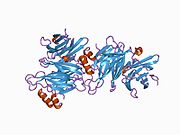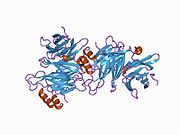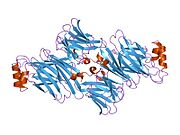CLTC
| CLTC | |||||||||||||||||||||||||||||||||||||||||||||||||||
|---|---|---|---|---|---|---|---|---|---|---|---|---|---|---|---|---|---|---|---|---|---|---|---|---|---|---|---|---|---|---|---|---|---|---|---|---|---|---|---|---|---|---|---|---|---|---|---|---|---|---|---|
 | |||||||||||||||||||||||||||||||||||||||||||||||||||
| |||||||||||||||||||||||||||||||||||||||||||||||||||
| Identifiers | |||||||||||||||||||||||||||||||||||||||||||||||||||
| Aliases | CLTC, CHC, CHC17, CLH-17, CLTCL2, Hc, clathrin heavy chain, MRD56 | ||||||||||||||||||||||||||||||||||||||||||||||||||
| External IDs | OMIM: 118955; MGI: 2388633; HomoloGene: 3572; GeneCards: CLTC; OMA:CLTC - orthologs | ||||||||||||||||||||||||||||||||||||||||||||||||||
| |||||||||||||||||||||||||||||||||||||||||||||||||||
| |||||||||||||||||||||||||||||||||||||||||||||||||||
| |||||||||||||||||||||||||||||||||||||||||||||||||||
| |||||||||||||||||||||||||||||||||||||||||||||||||||
| |||||||||||||||||||||||||||||||||||||||||||||||||||
| Wikidata | |||||||||||||||||||||||||||||||||||||||||||||||||||
| |||||||||||||||||||||||||||||||||||||||||||||||||||
Clathrin heavy chain 1 is a protein that in humans is encoded by the CLTC gene.[5][6]
Clathrin is a major protein component of the cytoplasmic face of intracellular organelles, called coated vesicles and coated pits. These specialized organelles are involved in the intracellular trafficking of receptors and endocytosis of a variety of macromolecules. The basic subunit of the clathrin coat is composed of three heavy chains and three light chains.[7]
Interactions
CLTC has been shown to interact with PICALM[8] and HGS.[9]
See also
References
- ^ a b c GRCh38: Ensembl release 89: ENSG00000141367 – Ensembl, May 2017
- ^ a b c GRCm38: Ensembl release 89: ENSMUSG00000047126 – Ensembl, May 2017
- ^ "Human PubMed Reference:". National Center for Biotechnology Information, U.S. National Library of Medicine.
- ^ "Mouse PubMed Reference:". National Center for Biotechnology Information, U.S. National Library of Medicine.
- ^ Dodge GR, Kovalszky I, McBride OW, Yi HF, Chu ML, Saitta B, Stokes DG, Iozzo RV (Feb 1992). "Human clathrin heavy chain (CLTC): partial molecular cloning, expression, and mapping of the gene to human chromosome 17q11-qter". Genomics. 11 (1): 174–8. doi:10.1016/0888-7543(91)90115-U. PMID 1765375.
- ^ Nomura N, Miyajima N, Sazuka T, Tanaka A, Kawarabayasi Y, Sato S, Nagase T, Seki N, Ishikawa K, Tabata S (Dec 1995). "Prediction of the coding sequences of unidentified human genes. I. The coding sequences of 40 new genes (KIAA0001-KIAA0040) deduced by analysis of randomly sampled cDNA clones from human immature myeloid cell line KG-1". DNA Res. 1 (1): 27–35. doi:10.1093/dnares/1.1.27. PMID 7584026.
- ^ "Entrez Gene: CLTC clathrin, heavy chain (Hc)".
- ^ Tebar, F; Bohlander S K; Sorkin A (Aug 1999). "Clathrin assembly lymphoid myeloid leukemia (CALM) protein: localization in endocytic-coated pits, interactions with clathrin, and the impact of overexpression on clathrin-mediated traffic". Mol. Biol. Cell. 10 (8): 2687–702. doi:10.1091/mbc.10.8.2687. ISSN 1059-1524. PMC 25500. PMID 10436022.
- ^ Raiborg, C; Bache K G; Mehlum A; Stang E; Stenmark H (Sep 2001). "Hrs recruits clathrin to early endosomes". EMBO J. 20 (17): 5008–21. doi:10.1093/emboj/20.17.5008. ISSN 0261-4189. PMC 125612. PMID 11532964.
This article incorporates text from the United States National Library of Medicine, which is in the public domain.
Further reading
- Murphy JE, Keen JH (1992). "Recognition sites for clathrin-associated proteins AP-2 and AP-3 on clathrin triskelia". J. Biol. Chem. 267 (15): 10850–5. doi:10.1016/S0021-9258(19)50096-5. PMID 1587861.
- Corvera S (1990). "Insulin stimulates the assembly of cytosolic clathrin onto adipocyte plasma membranes". J. Biol. Chem. 265 (5): 2413–6. doi:10.1016/S0021-9258(19)39811-4. PMID 2154445.
- Scarmato P, Kirchhausen T (1990). "Analysis of clathrin light chain-heavy chain interactions using truncated mutants of rat liver light chain LCB3". J. Biol. Chem. 265 (7): 3661–8. doi:10.1016/S0021-9258(19)39644-9. PMID 2406259.
- Hanspal M, Luna E, Branton D (1984). "The association of clathrin fragments with coated vesicle membranes". J. Biol. Chem. 259 (17): 11075–82. doi:10.1016/S0021-9258(18)90624-1. PMID 6147350.
- Nomura N, Miyajima N, Sazuka T, et al. (1995). "Prediction of the coding sequences of unidentified human genes. I. The coding sequences of 40 new genes (KIAA0001-KIAA0040) deduced by analysis of randomly sampled cDNA clones from human immature myeloid cell line KG-1 (supplement)". DNA Res. 1 (1): 47–56. doi:10.1093/dnares/1.1.47. PMID 7584028.
- Fausser JL, Ungewickell E, Ruch JV, Lesot H (1994). "Interaction of vinculin with the clathrin heavy chain". J. Biochem. 114 (4): 498–503. doi:10.1093/oxfordjournals.jbchem.a124206. PMID 8276759.
- Kedra D, Peyrard M, Fransson I, et al. (1997). "Characterization of a second human clathrin heavy chain polypeptide gene (CLH-22) from chromosome 22q11". Hum. Mol. Genet. 5 (5): 625–31. doi:10.1093/hmg/5.5.625. PMID 8733129.
- Goodman OB, Krupnick JG, Gurevich VV, et al. (1997). "Arrestin/clathrin interaction. Localization of the arrestin binding locus to the clathrin terminal domain". J. Biol. Chem. 272 (23): 15017–22. doi:10.1074/jbc.272.23.15017. PMID 9169477.
- Ramjaun AR, Micheva KD, Bouchelet I, McPherson PS (1997). "Identification and characterization of a nerve terminal-enriched amphiphysin isoform". J. Biol. Chem. 272 (26): 16700–6. doi:10.1074/jbc.272.26.16700. PMID 9195986.
- McMahon HT, Wigge P, Smith C (1997). "Clathrin interacts specifically with amphiphysin and is displaced by dynamin". FEBS Lett. 413 (2): 319–22. doi:10.1016/S0014-5793(97)00928-9. PMID 9280305. S2CID 42520828.
- Foti M, Mangasarian A, Piguet V, et al. (1998). "Nef-mediated clathrin-coated pit formation". J. Cell Biol. 139 (1): 37–47. doi:10.1083/jcb.139.1.37. PMC 2139808. PMID 9314527.
- Dell'Angelica EC, Klumperman J, Stoorvogel W, Bonifacino JS (1998). "Association of the AP-3 adaptor complex with clathrin". Science. 280 (5362): 431–4. Bibcode:1998Sci...280..431D. doi:10.1126/science.280.5362.431. PMID 9545220.
- Ramjaun AR, McPherson PS (1998). "Multiple amphiphysin II splice variants display differential clathrin binding: identification of two distinct clathrin-binding sites". J. Neurochem. 70 (6): 2369–76. doi:10.1046/j.1471-4159.1998.70062369.x. PMID 9603201. S2CID 21910795.
- ter Haar E, Musacchio A, Harrison SC, Kirchhausen T (1998). "Atomic structure of clathrin: a beta propeller terminal domain joins an alpha zigzag linker". Cell. 95 (4): 563–73. doi:10.1016/S0092-8674(00)81623-2. PMC 4428171. PMID 9827808.
- Laporte SA, Oakley RH, Zhang J, et al. (1999). "The beta2-adrenergic receptor/betaarrestin complex recruits the clathrin adaptor AP-2 during endocytosis". Proc. Natl. Acad. Sci. U.S.A. 96 (7): 3712–7. Bibcode:1999PNAS...96.3712L. doi:10.1073/pnas.96.7.3712. PMC 22359. PMID 10097102.
- Turner CE, Brown MC, Perrotta JA, et al. (1999). "Paxillin LD4 motif binds PAK and PIX through a novel 95-kD ankyrin repeat, ARF-GAP protein: A role in cytoskeletal remodeling". J. Cell Biol. 145 (4): 851–63. doi:10.1083/jcb.145.4.851. PMC 2133183. PMID 10330411.
- Hussain NK, Yamabhai M, Ramjaun AR, et al. (1999). "Splice variants of intersectin are components of the endocytic machinery in neurons and nonneuronal cells". J. Biol. Chem. 274 (22): 15671–7. doi:10.1074/jbc.274.22.15671. PMID 10336464.
- Ybe JA, Brodsky FM, Hofmann K, et al. (1999). "Clathrin self-assembly is mediated by a tandemly repeated superhelix". Nature. 399 (6734): 371–5. Bibcode:1999Natur.399..371Y. doi:10.1038/20708. PMID 10360576. S2CID 4406014.
External links
- Human CLTC genome location and CLTC gene details page in the UCSC Genome Browser.
- v
- t
- e
-
 1b89: CLATHRIN HEAVY CHAIN PROXIMAL LEG SEGMENT (BOVINE)
1b89: CLATHRIN HEAVY CHAIN PROXIMAL LEG SEGMENT (BOVINE) -
 1bpo: CLATHRIN HEAVY-CHAIN TERMINAL DOMAIN AND LINKER
1bpo: CLATHRIN HEAVY-CHAIN TERMINAL DOMAIN AND LINKER -
 1c9i: PEPTIDE-IN-GROOVE INTERACTIONS LINK TARGET PROTEINS TO THE B-PROPELLER OF CLATHRIN
1c9i: PEPTIDE-IN-GROOVE INTERACTIONS LINK TARGET PROTEINS TO THE B-PROPELLER OF CLATHRIN -
 1c9l: PEPTIDE-IN-GROOVE INTERACTIONS LINK TARGET PROTEINS TO THE B-PROPELLER OF CLATHRIN
1c9l: PEPTIDE-IN-GROOVE INTERACTIONS LINK TARGET PROTEINS TO THE B-PROPELLER OF CLATHRIN -
 1utc: CLATHRIN TERMINAL DOMAIN COMPLEXED WITH TLPWDLWTT
1utc: CLATHRIN TERMINAL DOMAIN COMPLEXED WITH TLPWDLWTT
 | This article on a gene on human chromosome 17 is a stub. You can help Wikipedia by expanding it. |
- v
- t
- e





















